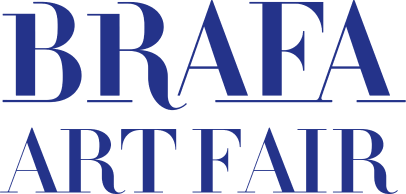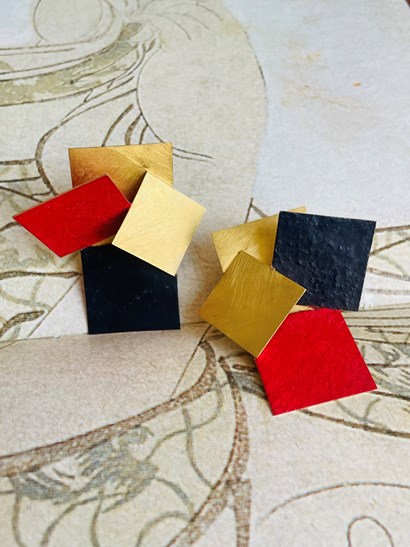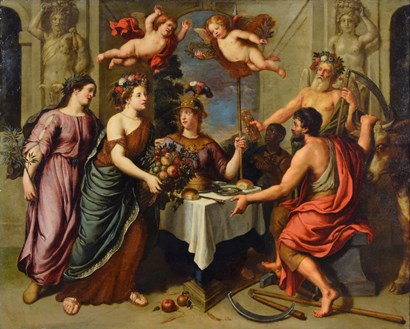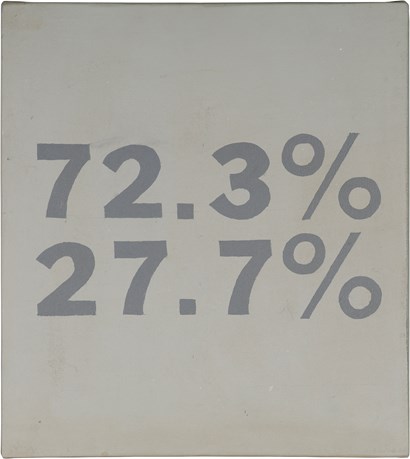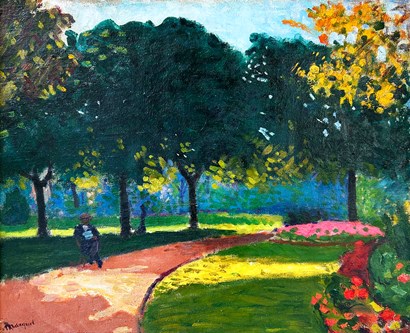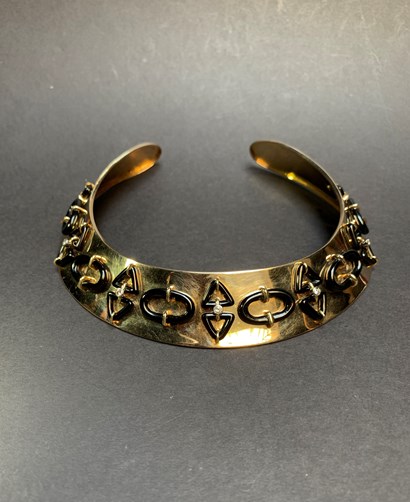This section will be available this Autumn.
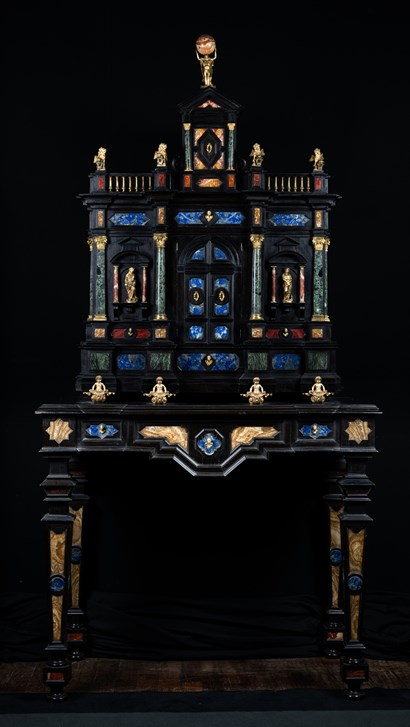
Carlucci Gallery
Roman Cabinat, circa 1780 Ebony veneered, marble and various polychrome stones H 208 x W 105 x D 62 cm Provenance: private collection Cabinet veneered in ebony, marble, and polychrome stones, with an architectural design. The upper section features a tympanum surmounted by Hercules holding the globe in flowering alabaster. A pierced balustrade is crowned with figures of a winged lion bearing a heraldic shield. The façade is articulated with a central door and two lateral doors, each concealing interior disappearing drawers. Materials include jasper, lapis lazuli, breccia, alabaster, and antique green marble.
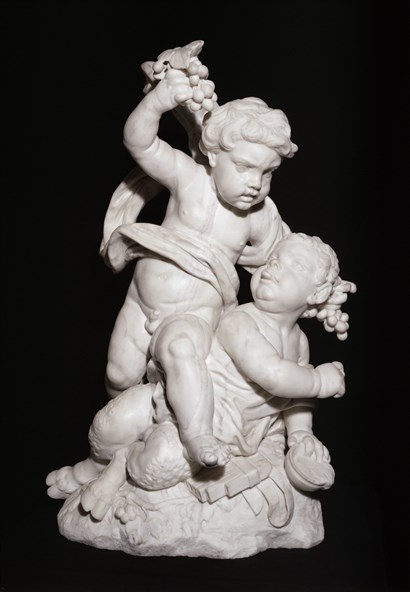
Romigioli Antichità
giuseppe piamontini
Giuseppe Piamontini (Florence, 1664-1744) Small Faun playing with a Satyr, 1710 Carrara marble H 79 cm Signed and dated 1710 Provenance: private collection, Florence Literature: Sandro Bellesi, I marmi di Giuseppe Piamontini, ed. Polistampa 2008 Ideal pendant 'Eros and Anteros' at the Money Museum in Palazzo Pitti, Florence

TEMPLON
Martial Raysse (Nice, 1936) Now, 2017 Acrylic on canvas 209 x 175.5 cm Unique Provenance: the artist’s studio Literature: exhibition catalogue Martial Raysse: œuvres récentes, Musée Paul Valéry, Sète, France; Ed. Loubatières 2023, ill. p. 151 Exhibition: Martial Raysse: œuvres récentes, Musée Paul Valéry, Sète France, 2023
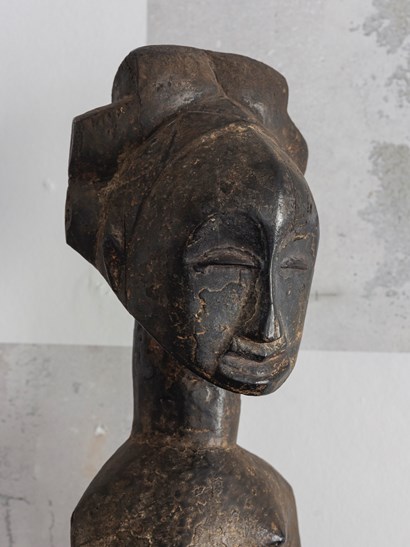
Galerie Flak
Hemba ancestor figure Singiti (commemorative portrait of a chief) Democratic Republic of Congo-Upper Congo River 19th century or early 20th century Carved wood H 86.5 cm Provenance: Mia van Bussel collection, Amsterdam; Kevin Conru collection, Brussels; Adrian Schlag collection, Brussels; Guilhem Montagut collection, Barcelona Literature: Lexikon der Afrikanischen Kunst, Karl-Ferdinand Schaedler, Munich, 1994, p. 242
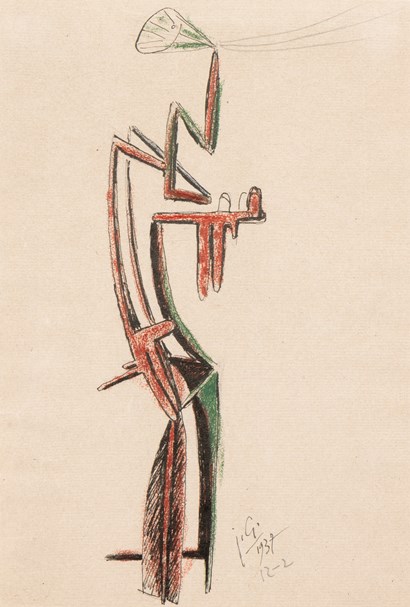
Brame & Lorenceau
julio gonzález
Julio González (Spain, Barcelona 1876-1942 Arcueil, France) Personnage au cornet, 1937 China ink and coloured pencil on paper 29 x 21 cm Signed and dated lower centre Provenance: private collection Literature: J. Gibert, Catalogue raisonné des dessins de Julio González, Projets pour sculptures personnages, Paris, 1975, vol. 9, p. 47 (ill.) Exhibition: New York, The Museum of Modern Art, Julio González, Drawings and Sculpture, February-April 1956, Minneapolis
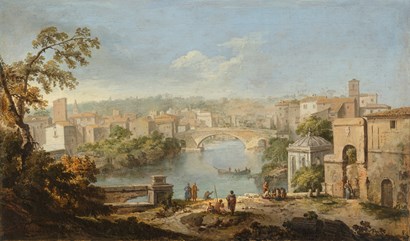
Galerie Alexis Bordes
paolo anesi
Paolo Anesi (Rome, 1697-1773) View of the Ponte Cestio from the Tiber island Oil on canvas 28 x 48 cm Provenance: anonymous sale, Paris, Hôtel Drouot (Maître Baudoin), May 31st, 1919, lot n° 98 (Vanvitelli, View of a city-houses rise on both banks of a river crossed by a stone bridge. In the foreground, on the ground to the right, a fragment of a fluted column and a broken capital); private collection, France Literature: Olivier Michel, Biographical Research on Paolo Anesi, in Publications de l'École Française de Rome, Vivre à peindre à Rome au XVIIIe siècle, vol. 217, 1996, pp. 319–334 Praised during his lifetime as one of the most brilliant vedute painters of the eighteenth century in Italy, Paolo Antonio Anesi nevertheless remains a figure whose life and work are still little studied. Active in Rome, Anesi never left his native city. The panoramas offered by its hills provided him with a multitude of striking viewpoints. The Aventine, one of Rome’s seven hills, appears to have been a favourite subject. To produce his painting, Anesi positioned himself on the Isola Tiberina, a small island in the middle of the Tiber, connected to the left bank by the Ponte Cestio and to the right bank by the Ponte Fabricio.

Galerie Greta Meert
carla accardi
Carla Accardi (Trapani 1924-2014 Rome) Frammenti, 1984 Acrylic on canvas 50 x 60 cm Frammenti, a work from 1984, ‘Fragments’; the work affirms Carla Accardi’s place as a voice of innovation in an Italian art scene dominated by male voices. In this 50 x 60 cm painting using only black paint on the untreated material of the canvas, the artist constructs a rhythmic interplay of signs animating recognition and illegibility, an evocation of a writing that dissolves into abstraction. The work embodies the tension that characterises her oeuvre: a subtle intertwining of classical painterly discipline and the radical openness of the avant-garde, resulting in a visual language that is as rigorous and experimental as it is personal.
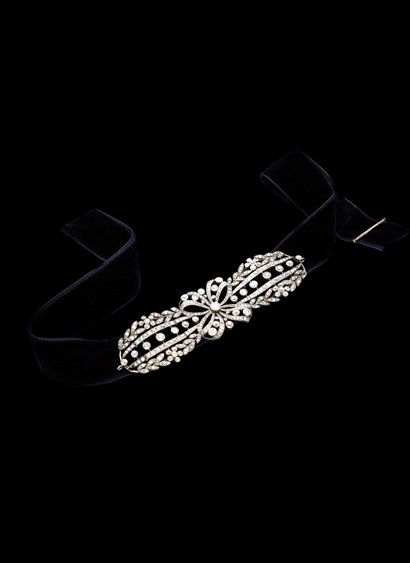
Pauline's Jewellery Box
Belle Epoque diamond tiara necklace, circa 1905 Platinum and diamonds Provenance: private collection, London An important Belle Epoque diamond tiara necklace, set with old European & rose cut diamonds. The estimated total diamond weight is approximately 12.00 carats. Estimated colour H-I on average. Estimated clarity VS-SI on average. The diamonds are bright & lively, mounted in platinum.
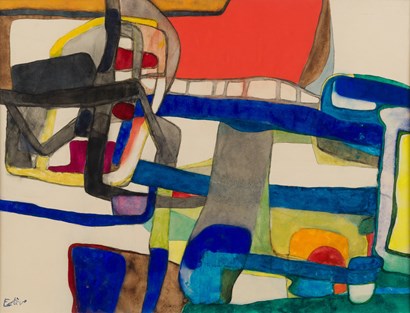
Stern Pissarro Gallery
maurice estève
Maurice Estève (Culan, 1904-2001) Untitled, circa 1953-1955 Gouache, watercolour and charcoal on paper 52.6 x 69.3 cm Signed lower left 'Estève' This work is registered in the archives of Mrs Monique Prudhomme-Estève under n° A.78 Provenance: private collection, UK This vibrant work by Maurice Estève dates from a pivotal moment in his career, when he was refining the style that would come to define his mature practice. A master of watercolor, this medium allowed him to develop a visual language characterized by subtle transparencies and rich chromatic nuances. The work features the bold colors and interlocking geometric forms that have made his oeuvre renowned, and its appealing format and quality make it a particularly attractive choice.
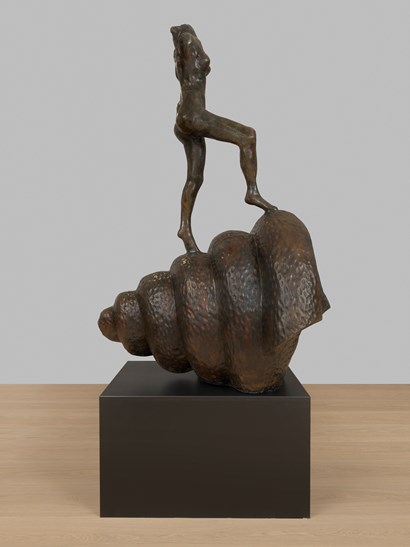
CKS Gallery
Salvador Dalí (Spain, Figueras 1904-1989) Nude ascending the staircase, 1973 Brown patina bronze sculpture H 212 × W 139 × D 117 cm - Height with the base: 297 cm Signed & numbered 'Dalí 2/8', Foundry mark 'Fratelli Bonvicini, Italie' on the shell Certificate of authenticity by M. Robert Descharnes and listed in the Descharnes Archives under the n° 0-264 Provenance: private collection
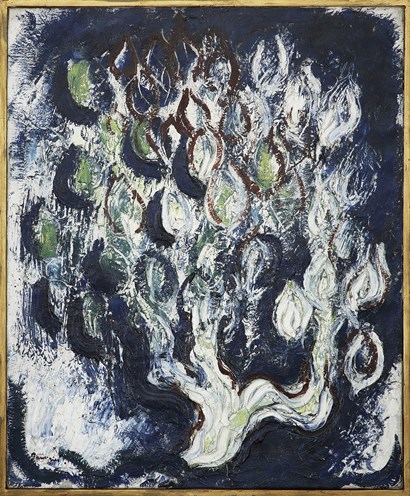
Galerie de la Béraudière
jean fautrier
Jean Fautrier (Paris 1898-1964 Châtenay-Malabry) Les feuilles vertes, 1934 Oil on canvas 73 x 60 cm Signed lower left 'Fautrier' Provenance: Jean Paulhan collection, France; Dominique Aury collection, France; private collection, France (by descent); Tajan, Paris, November 23rd, 2022, lot 44; private collection, Belgium Literature: Marie-José Lefort, Catalogue Raisonné de l'oeuvre peint de Jean Fautrier, Norma éditions, 2023, p. 293, n° 478 (ill.); Palma Bucarelli, Jean Fautrier, Pittura e materia, édition Il Saggiatore, Milan, 1960, ill. n° 107 p. 306 Exhibitions: 1974, Paris, Galeries nationales du Grand Palais, Jean Paulhan à travers ses peintres, cat. n° 563, p. 218

Galerie Flak
Yup'ik shaman mask Coastal Yup’ik - Eskimo, St Michael or Yukon river Delta, Alaska, 19th century Carved wood, pigments H 19.5 cm Provenance: Karin & Leo (1937-1987) Van Oosterom collection, The Hague, acquired in 1980 Yup’ik shamanic masks (from the Indigenous culture of the Arctic region of Alaska) bear witness to a spirituality and artistic power of remarkable depth. Exceptionally rare today - as most were destroyed or discarded after their ceremonial use - these works are imbued with mystery and poetry. Their evocative force and symbolism of metamorphosis deeply inspired Surrealist masters such as Max Ernst and Leonora Carrington, who discovered in them a new visual language of the unconscious. This striking mask represents a tunghak spirit - a powerful celestial being linked to the moon, the sun, and the balance between humans and nature.

Van Pruissen Asian Art
nagai ikka
Nagai Ikka (Japan, 1869–1940) Pair of six-panel folding screens with crows, 1930s Ink on paper H 137 x W 268 cm (each) Signed in the bottom corner Provenance: private collection, Japan Nagai Ikka (also known by the art names Zuiunan and Hanpo) was born in 1869 in Suibara, Niigata Prefecture, during the early Meiji period. He trained under leading masters of the Maruyama and Shijō schools, including Suzuki Shōnen, Nakano Kimei, and Hirafuku Hoan, and later absorbed stylistic influences from Kawanabe Kyōsai. This grounding in careful observation and naturalistic rendering provided the foundation for a personal style that balanced precision with expressive freedom. He began painting crow paintings after helping Ernest Francisco Fenollosa create 'One Hundred Crows', a painting he had commissioned from Kyosai. The late Meiji and Taishō periods were marked by profound change in Japanese art, as artists navigated between traditional aesthetics and the growing influence of Western naturalism. Ikka embraced this dialogue, drawing on classical ink painting techniques whilst expanding his horizons abroad. From 1903 to 1908, he lived in the United States, exhibiting at international events such as the Portland Expo, where he won a silver medal, and later at the Italian Expo. His crow paintings, admired both in Japan and overseas, earned him the affectionate nickname 'Doctor of Crows' from statesman Ōkuma Shigenobu. The crow (karasu) has a long symbolic tradition in Japanese culture, appearing in classical poetry, Buddhist imagery, and Shintō cosmology, most famously as Yatagarasu, the mythical three-legged crow. Ikka revitalised this motif, transforming it from a minor decorative element into the central subject of bold, dynamic compositions. This pair of six-panel folding screens demonstrates his command of movement and atmosphere. Painted in ink with sparing touches of colour, the crows appear in varied postures—perched, in flight, or interacting—creating a rhythm that guides the viewer’s eye across the expansive surface. Bold, calligraphic brushstrokes define wings and feathers, while softer washes evoke wind, mist, and shifting light. The result is a scene that is both naturalistic and poetic, combining the restraint of traditional ink painting with a striking modern vitality. Ikka’s crows are not static symbols but living presences, conveying alertness, intelligence, and social energy. His lifelong study of corvid behavior, informed by travels across Japan, Korea, China, Taiwan, and the United States, gave his work an observational depth rare among his contemporaries. At the same time, his art reflects a broader ambition: to elevate the ordinary into the emblematic, merging natural accuracy with expressive force. Today, Ikka’s crow paintings are prized by collectors and studied as important examples of Meiji-period nihonga, where fidelity to nature combines with enduring Japanese aesthetic ideals. These folding screens stand as a testament to his originality and his ability to transform a humble subject into a powerful symbol of vitality and freedom.

Galerie Berès
Georges Lemmen (Brussels, 1865-1916) Vue sur l'église de Dadizele, circa 1891 Oil on panel 16 x 24 cm Monogram lower right GL This work will be included in the forthcoming catalogue raisonné being prepared by Olivier Bertrand Literature: Roger Cardon, Georges Lemmen 1865-1916, Brussels, 1997, 40 p. 104

